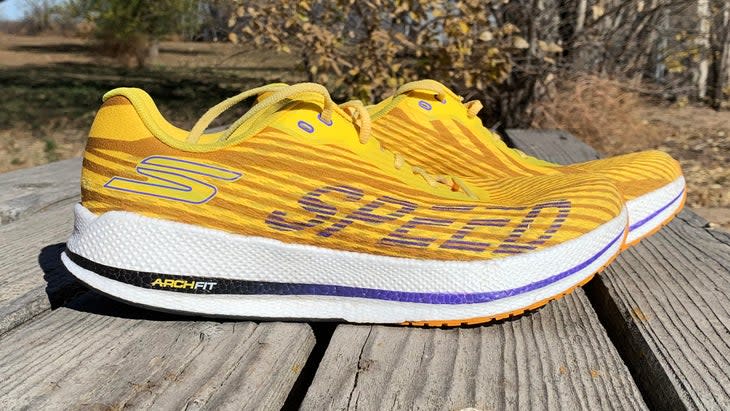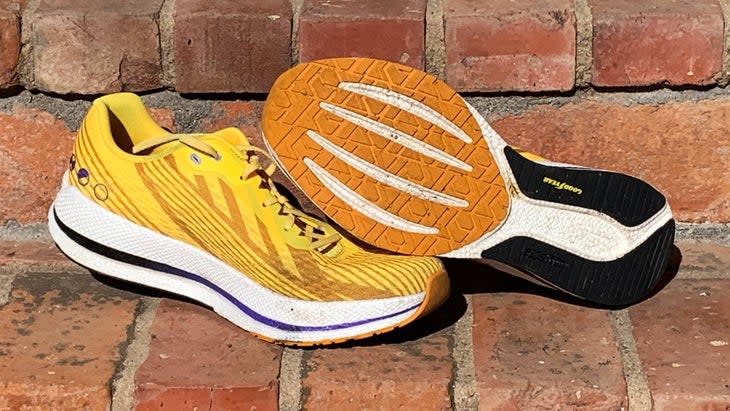Yes, Skechers Makes High-Performance Running Shoes. This Is the Best So Far.
This article originally appeared on Outside
Skechers GOrun Razor 4 Review
MSRP: $145
Weight: 8.0 ounces (M); 6.4 ounces (W)
Stack Height: 30-millimeter heel / 26-millimeter forefoot (4-millimeter drop)
I've been a fan of Skechers running shoes since their first GOrun model a decade ago. I gave an "Editor's Choice" award to the GOrun 4 in 2016, mostly for the exceptional fit of its circular knit upper, and I named the 2019 GOrun 7 Hyper one of the most innovative shoes of the year for its groundbreaking hyper burst midsole. I've run hundreds of miles training and racing in memorable Skechers models, but after two and a half weeks running in the new Razor 4, I'm ready to call it their best running shoe to date--and one of the best values in training shoes available today.
Skechers threw their hat in the performance ring back in 2011 when the minimalist movement spurred widespread innovation and new shoe companies sprouted around the globe. Skechers first performance running shoe was a light, low-to-the-ground, flexible model with a heel-to-toe rocker that was supposed to encourage a mid-foot touchdown. Runners were skeptical that the California brand, founded in 1992 and known mostly for its casual kicks, could make a serious running shoe. But the GOrun won a loyal following for its comfortable, smooth, and speedy ride.
That following grew considerably when the brand sponsored Olympic marathon medalist Meb Keflezighi, who won the 2014 Boston Marathon in a pair of Skechers. Since then, while the running division continues to be largely overshadowed by the lifestyle persona, the footwear brand has quietly stayed at the forefront of new technologies and design, creating a range of lightweight, comfortable, high-performing shoes at reasonable prices.

The Razor 4 continues that tradition. Since the debut of the Razor 3 in late 2018, the brand has launched a Razor+, Razor Elite, and Razor Excess 1 and 2. The Razor 4, which has the same stack heights as the Excess, will replace them all and refine the franchise's position in the Skechers shoe line-up.
"The Razor has always teetered between race shoe or daily trainer," says Keith Shelton, Skechers' senior director of product development. The first Razor weighed in at 7.7 ounces in men's size 9 and toed the trainer/racer line well. By version 3, however, it was down to 6.6 ounces. "The three went a little too much on the racing side. With Razor 4, we've come back to a truer, uptempo, speed-workout trainer."
The Razor 4 weighs 8.0 ounces, over 20 percent more than the 3. In no way, however, is it a step backwards. Most of that heft comes from the new midsole foam, which Skechers calls Hyper Burst Pro. Hyper Burst, which Skechers introduced in 2018, is created using a supercritical foaming process. Briefly, a base material is saturated with heated and pressurized liquid CO2, then, when the liquid returns to its normal gaseous state it expands the foam by creating thousands of gas-filled bubbles trapped within the midsole. Bottom line, the resulting material is lighter, bouncier, and more resilient than previous materials.
The original Hyper Burst was created from EVA, and it reminded me of high-end packing materials you find surrounding expensive scientific instruments--molded foams that cushion while holding their shape to protect the sensitive cargo from jostling around. EVA-based Hyper Burst midsoles cushioned the contours of the feet, but didn't displace and bounce back much. The foam felt a bit plasticky to the touch, and delivered a firm, quick ride that I, and many others, enjoyed in racing models, but found a bit too stiff for daily training and longer runs.
The new Hyper Burst Pro starts as TPU beads, which gives it a more rubbery, springier feel. It's a similar material as used in some supershoes, like the Adidas Adizero Pro 3. As soon as I picked up the Razor 4, I immediately noticed how much softer the new midsole material felt to the touch. "When you squeeze it, it feels soft, but you can also feel it pushing your fingers back out," says Shelton." And the harder you squeeze it the more it pushes back."
On the road, that's exactly how it responded under my feet: The foam sunk in, delivering a soft, smooth touchdown, then firmed up almost immediately into a bouncy, lively underfoot platform. The increased softness let the sole conform more on landing, which seemed to make the heel-to-toe transition smoother, and allowed the forefoot to flex easier than on previous Razors. But the shoe never felt sloppy or sluggish. "You're not sinking in that much," says Shelton. "It gets you off the toe fast, because the cycle time of when you sink in and when the foam returns that energy is really fast with the TPU."
Enhancing that quick toe-off is a partial plate made of carbon-infused pebax. Technically, it's not a plate but two strips of material that surround the sides of the forefoot, each with a bar attached to the middle that extends partly across the shoe, forming a rough "H" shape. This H-plate flexes easily and doesn't rock you forward or alter your stride like the full, rigid plates found in supershoes. The only thing I noticed was that my forefoot stance and push-off felt confidently stable and powerful--which is what the plate is designed to do. "It's not meant to be a lever arm or anything tricky," Shelton says. "It's just to provide more shear resistance and stability in forefoot, and to give a little snappier toe-off." The combination of a bouncy foam and embedded plate puts the Razor in the semi-supershoe category, although it has a lower stack height and more ground feel than many of its peers.
I enjoyed the ride of the new sole, which made my feet feel cared for on longer runs and fast on speed days. But what sealed my love for this shoe was the fit. Recently, I've found that the shape of several Skechers models didn't seem to quite match my foot and the stiff upper material rubbed me the wrong way. The fit of the Razor 4, however, reminds me of the foot-hugging wrap of the brand's award-winning 2016 model, holding my foot snuggly and securely without getting in the way anywhere.
Surprisingly, Shelton says that the base fabric--a blend of hyper mono mesh and polyester--is the same as that used on other recent models. This version is more comfortable because they replaced sublimation printing--a process that takes a lot of heat and water and leaves materials firm and stiff--with a print dye process that keeps the fabric soft. They also refined the mix of mono mesh and polyester in different parts of the upper, making it more flexible and forgiving in some spots, and more supportive in others where needed. Plus they added a bit more padding around the heel collar.
Shelton says that I'm also likely feeling the additional room created by relaxing how tightly the upper is pulled down when it is attached to the midsole. And, while the shoe’s last is the same, the sole is a few millimeters wider in the forefoot than previous Razors, improving both the fit and the underfoot stability.

In keeping with the goal of moving the Razor back into the training category, the outsole covers more of the shoe bottom with thicker, luggier rubber, increasing traction and durability. The more resilient outsole and midsole makes this a shoe you can wear nearly every day, but it still feels best when you're cruising at tempo pace or faster.
I'd recommend the Razor 4 for virtually any runner--some to use it as a daily trainer, others reserved for uptempo runs. As for me, I keep reaching for it when I head out in the morning, even when I should be testing other models. And the shoe has already migrated from the "need to test" rack to the "keep" rack in my garage.
Bottom Line
A bargain of a shoe that makes the popular Razor more accessible to more runners for more training days, while still feeling light and lively
Similar Shoes
Altra Vanish Tempo, Brooks Hyperion Tempo, Asics Magic Speed 2, Puma Deviate Nitro 2, Reebok Floatride Energy X, Topo Specter
For exclusive access to all of our fitness, gear, adventure, and travel stories, plus discounts on trips, events, and gear, sign up for Outside+ today.

